SICK Hungary: Efficient Production Logistics with Open Shuttles
The SICK AG, headquartered in Waldkirch, Germany, is one of the world’s leading providers of intelligent sensor solutions for automating factories, logistics and processes. The company has a strong global presence, as demonstrated by their over 10,000 employees across 63 subsidiaries. SICK’s factory in Kunsziget, Hungary has around 800 employees and has established itself as an essential part of the company’s manufacturing network.
In order to support their constant growth, SICK performed a comprehensive expansion of their infrastructure in Hungary by adding three new halls: one for goods-in, one for manufacturing (for a total of four manufacturing halls) and one for the small parts warehouse. These additions form the infrastructure SICK can rely on to handle their increasing order numbers. This investment includes a fully automatic storage system, a fleet of Open Shuttles and the digitization of SICK’s internal productions logistics with an end-to-end SAP® EWM solution by KNAPP.
Open Shuttles
Automated small parts warehouse
Picking
Software
You are currently viewing a placeholder content from YouTube. To access the actual content, click the button below. Please note that doing so will share data with third-party providers.
More InformationOne of the major advantages is that the system is geared towards the future, with capacity for today as well as tomorrow. We trust in logistics support from KNAPP.
Laszlo Varga
Supply Chain Manager bei SICK Kft.
Are you looking to automate your production logistics?
Get in touch with our experts today.
Seamless material flow with maximum flexibility for production logistics
Seamless connection of all production halls
Just-in-time production logistics
Room for expansion
Solution with SICK sensors
Floorspace optimization
End-to-end SAP® system environment
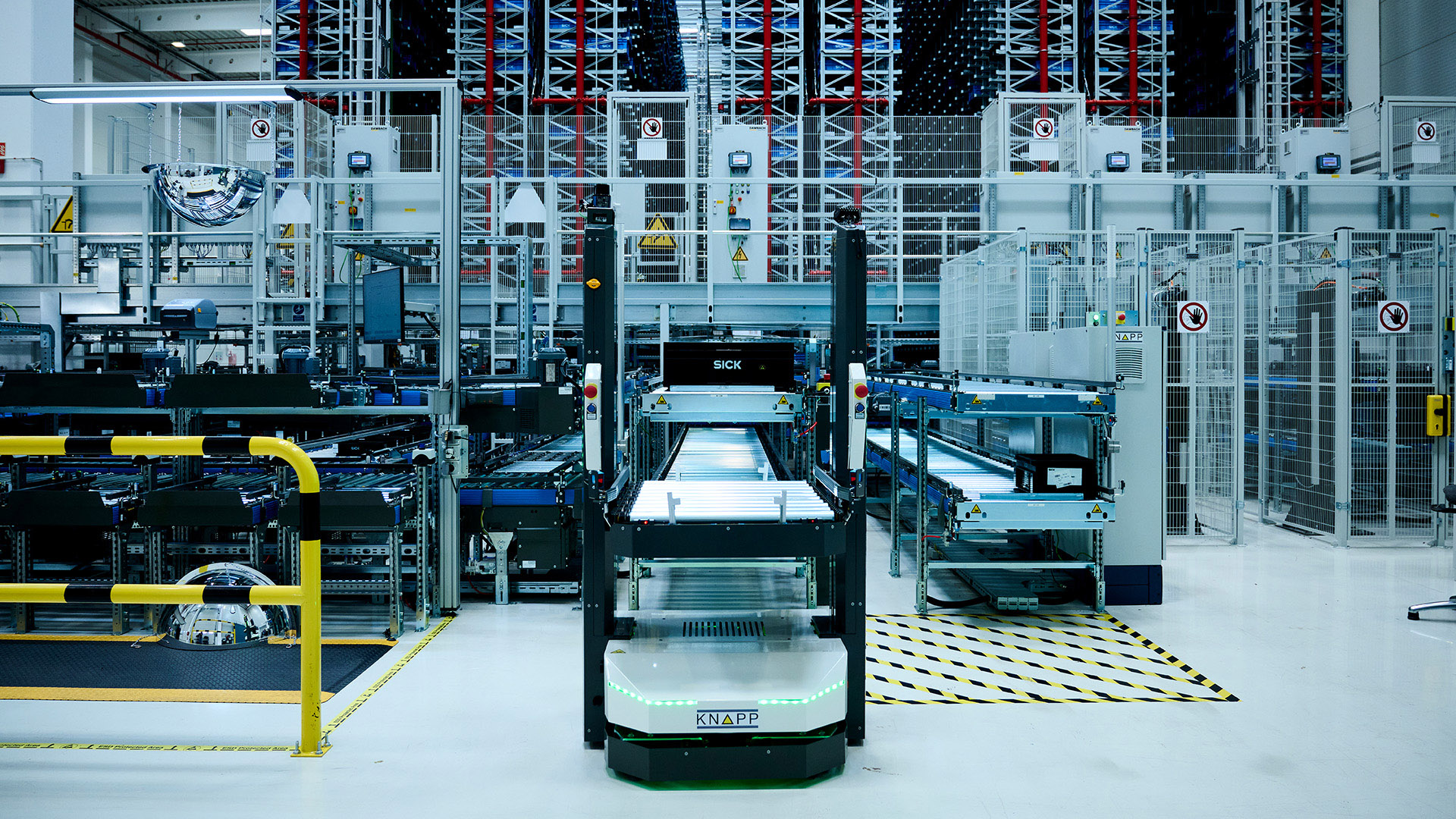
Automated production logistics in the entire factory
The new solution delivers winning production logistics, including seamless connection between goods-in, storage, picking and production. The backbone of in-house transport logistics is formed by 27 Open Shuttle autonomous mobile robots (AMRs), which transport containers and connect the automated small parts warehouse (AS/RS) directly to the manufacturing halls. The automated small parts warehouse with 52,000 storage locations features stacker cranes which store and retrieve raw materials and semi-finished goods in three different container sizes stored double and quadruple-deep in the racks. Two ergonomic Pick-it-Easy work stations enable efficient goods-to-person picking. A conveyor suspended from the ceiling connects the goods-in area with the small parts warehouse, ensuring a closed, all-encompassing material flow.
The new system has the advantage of fully automated storage and retrieval processes and just-in-time supply to manufacturing, around the clock, right when needed.
Laszlo Varga
Supply Chain Manager bei SICK Kft.
Are you looking for autonomous mobile robots (AMRs) for your warehouse?
Learn more about the Open Shuttles by KNAPP!
Autonomous mobile robots and automated small parts warehouse fully automate processes
1 I Goods-in
Small parts needed for production arrive in cartons or containers on pallets. Most incoming parts are repacked into containers, registered in the system and transferred to the conveyor system by the employees at the two pack stations. Parts that are not repacked are transported away after being registered. An integrated scale checks the weight of the containers. The containers move up a spiral conveyor to the suspended conveyor, which conveys them to the small parts warehouse.
2 I Storage
Stacker cranes put raw materials and semi-finished goods away in the automated small parts warehouse. The system holds a total of 52,000 storage locations spread across four aisles and 28 levels. Three different container types, with and without lids, are stored in the small parts warehouse. Containers sized 600 x 400 mm (24 x 16 in) are stored double-deep and those sized 400 x 300 mm (16 x 12 in) are stored quadruple-deep, with four stacker cranes handling putaway and retrieval. Both the picking stations and the Open Shuttles connect directly to the small parts warehouse, which supplies all the production areas from a central point.

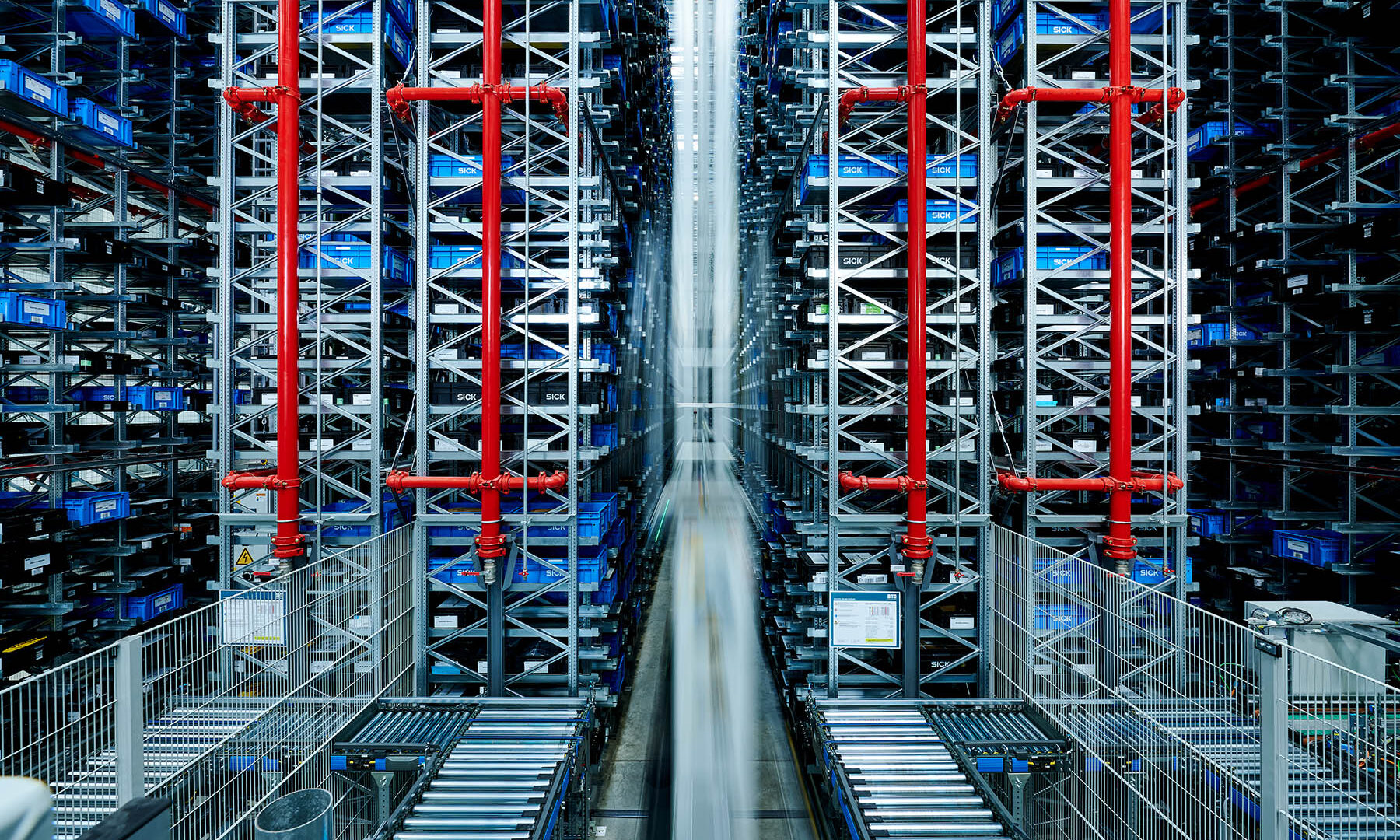
3 I Picking
Goods needed for production are picked at two ergonomic Pick-it-Easy work stations using a goods-to-person procedure. Processes at the work stations are digitally depicted on a screen, guiding the picking of goods and the return to storage via conveyor to the small parts warehouse. Each container holds just one item type, ensuring unmixed picking. About 50 % of the items stored in the small parts warehouse are processed at the picking work stations; the rest are conveyed directly to production by the Open Shuttles.
4 I Production logistics
Twenty-seven Open Shuttles run between the small parts warehouse and production areas in the four halls. The AMRs pick up the containers from specially designed spur conveyors and transport them to the production area. There, they are transferred to flow racks from which the employees can take the containers as needed. The flow racks are also where semi-finished goods are placed to be picked up by the Open Shuttles and returned to the small parts warehouse. On their way, the Open Shuttles must pass through rapid action doors. A control module communicates with the Open Shuttle to open and close the doors automatically.

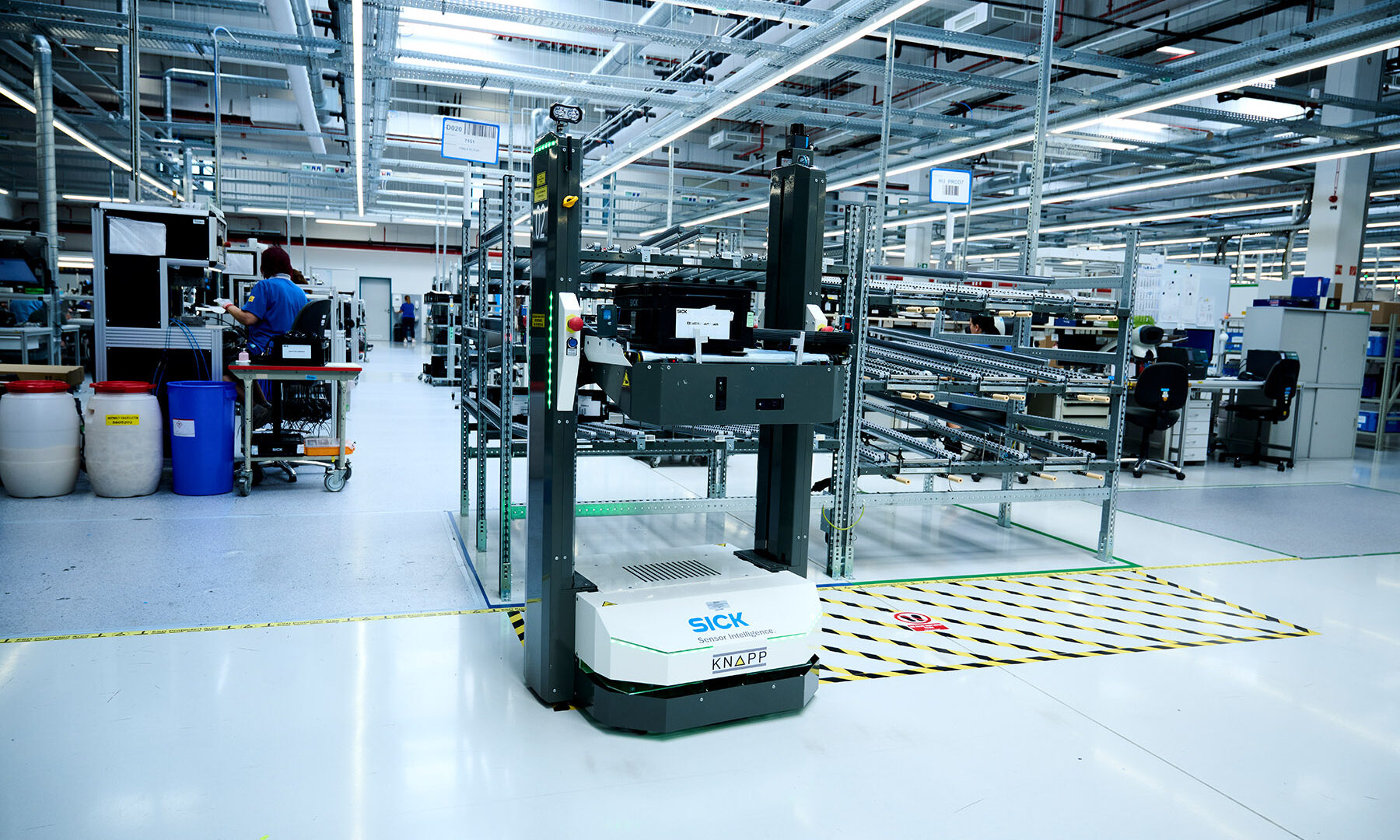
5 I Goods-out
Finished goods are sorted into containers and assembled by order on pallets in the production area. Tugger trains pick up the pallets from production and transport them to goods-out, where they are wrapped in film. The goods undergo final processing in the system and are provided with shipping documents, after which they are shipped out to other SICK subsidiaries.
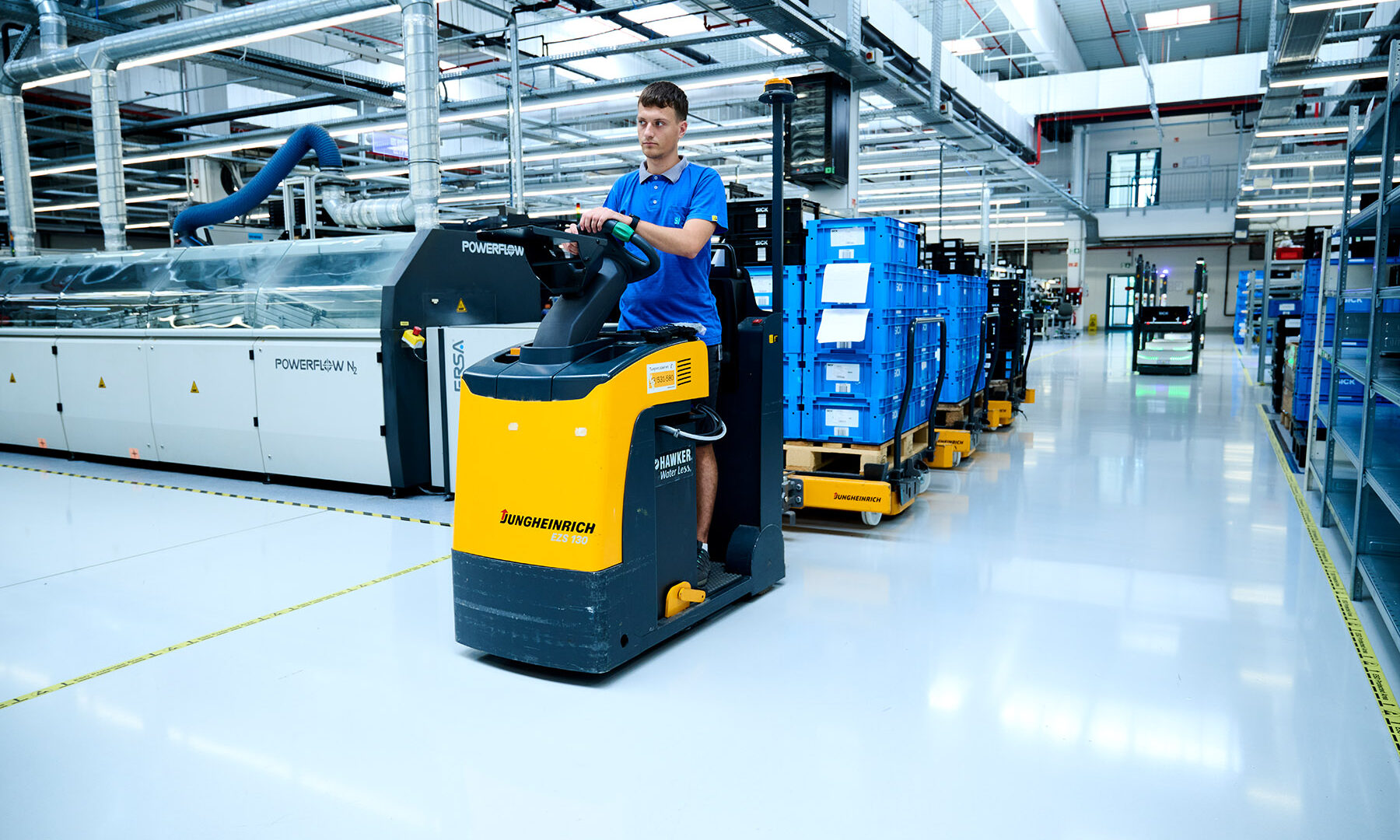
Autonomous mobile robots and automated small parts warehouse fully automate processes
1 I Goods-in
Small parts needed for production arrive in cartons or containers on pallets. Most incoming parts are repacked into containers, registered in the system and transferred to the conveyor system by the employees at the two pack stations. Parts that are not repacked are transported away after being registered. An integrated scale checks the weight of the containers. The containers move up a spiral conveyor to the suspended conveyor, which conveys them to the small parts warehouse.

2 I Storage
Stacker cranes put raw materials and semi-finished goods away in the automated small parts warehouse. The system holds a total of 52,000 storage locations spread across four aisles and 28 levels. Three different container types, with and without lids, are stored in the small parts warehouse. Containers sized 600 x 400 mm (24 x 16 in) are stored double-deep and those sized 400 x 300 mm (16 x 12 in) are stored quadruple-deep, with four stacker cranes handling putaway and retrieval. Both the picking stations and the Open Shuttles connect directly to the small parts warehouse, which supplies all the production areas from a central point.

3 I Picking
Goods needed for production are picked at two ergonomic Pick-it-Easy work stations using a goods-to-person procedure. Processes at the work stations are digitally depicted on a screen, guiding the picking of goods and the return to storage via conveyor to the small parts warehouse. Each container holds just one item type, ensuring unmixed picking. About 50 % of the items stored in the small parts warehouse are processed at the picking work stations; the rest are conveyed directly to production by the Open Shuttles.

4 I Production logistics
Twenty-seven Open Shuttles run between the small parts warehouse and production areas in the four halls. The AMRs pick up the containers from specially designed spur conveyors and transport them to the production area. There, they are transferred to flow racks from which the employees can take the containers as needed. The flow racks are also where semi-finished goods are placed to be picked up by the Open Shuttles and returned to the small parts warehouse. On their way, the Open Shuttles must pass through rapid action doors. A control module communicates with the Open Shuttle to open and close the doors automatically.

5 I Goods-out
Finished goods are sorted into containers and assembled by order on pallets in the production area. Tugger trains pick up the pallets from production and transport them to goods-out, where they are wrapped in film. The goods undergo final processing in the system and are provided with shipping documents, after which they are shipped out to other SICK subsidiaries.

Open Shuttles
flow racks
m² (280,000 ft²) storage space
storage locations
Autonomous, just-in-time transport of goods
The AMRs and the small parts warehouse with stacker cranes work together harmoniously to achieve flexible and efficient production logistics for all four halls at SICK. The Open Shuttles transport containers and supply them to the production lines seamlessly, picking up containers with components from the conveyor and bringing them to the manufacturing areas. A total of 30 flow racks serve as transfer points for providing and returning materials. Semi-finished goods are also picked up by the Open Shuttles and brought to the small parts warehouse. The AMRs navigate safely and reliably through all four production halls, in one-way as well as two-way traffic, sharing the paths with employees and tugger trains. Access between the halls is through rapid action doors, which are autonomously controlled by the Open Shuttles.
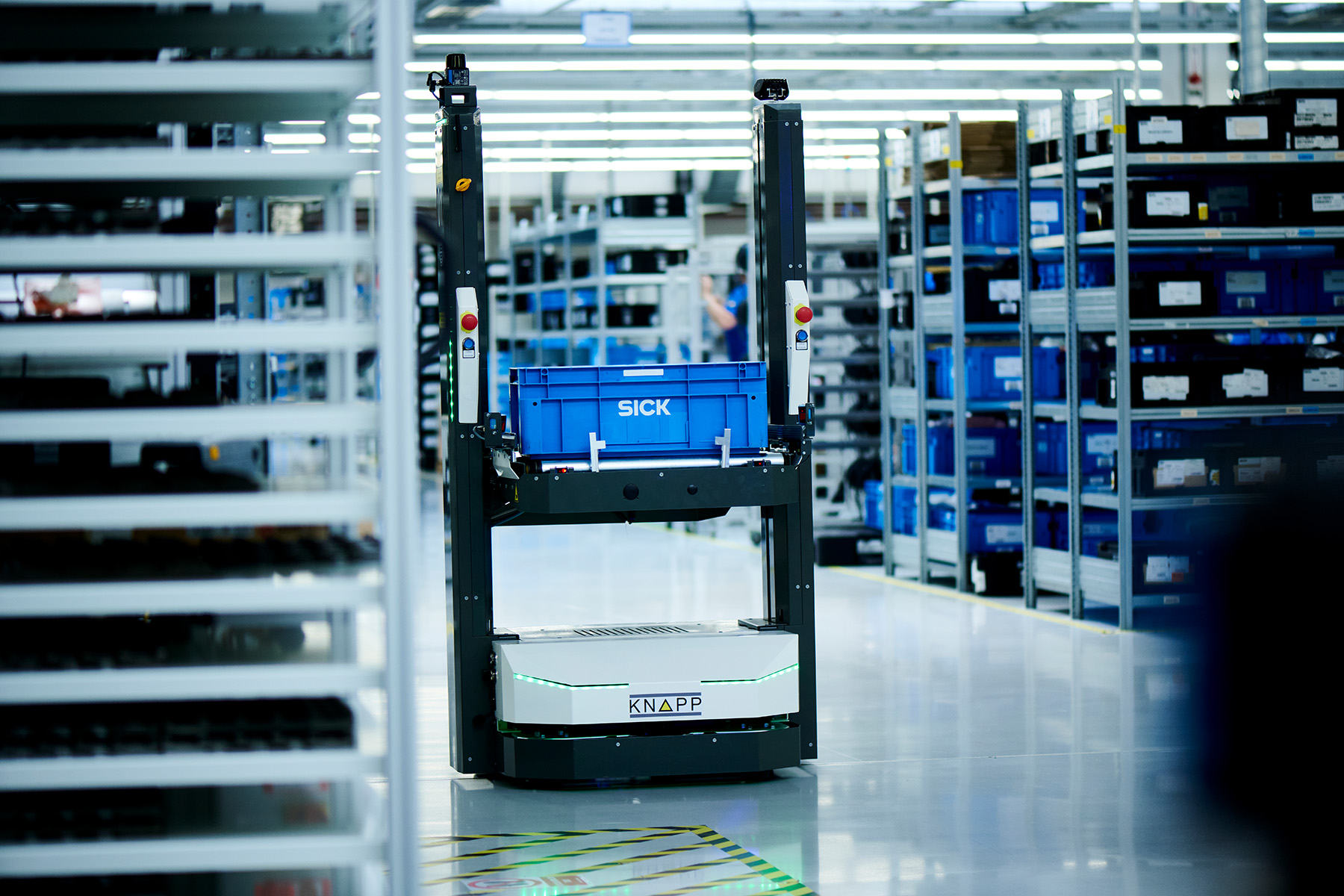
27 Open Shuttles
30 flow racks
SICK sensors
Easy integration
High flexibility
Maximum safety
End-to-end SAP® system for sustainable growth at SICK

The decentralized SAP® EWM on S/4HANA serves as a warehouse management system (WMS) and warehouse control system (WCS). It controls all material flows and processes the logic of all the automation technologies. The new software solution, which includes a material flow system (MFS), precisely controls the load-handling devices in the automated small parts warehouse with quadruple-deep storage. Additionally, KiSoft Fleet Control System (FCS), which controls the Open Shuttles, is integrated directly into SAP® EWM MFS through a REST interface. The well-connected SAP® EWM controls all storage and retrieval movements, including different methods of supplying goods to production, from planning complex tugger train paths to allocating individual rush orders to individual manufacturing stations. User-friendly dialogs at the goods-to-person work stations round out the SAP® EWM solution by KNAPP.
SAP® EWM
KiSoft FCS
KiSoft SCADA
User-friendly user interfaces
From sensors to technology partnership
SICK and KNAPP have a long, successful history of working together. The many projects shared – including one at the Waldkirch headquarters – show that this partnership is much more than just a classic customer-supplier relationship. The technological as well as strategic partnership drives innovation forward for both companies. SICK sensors have long been an integral part of KNAPP’s automation solutions, adding precision and performance. This makes the latest project in Kunsziget, Hungary, all the more significant, as – for the first time – only sensors by SICK will be used in the automation. Integrating the Open Shuttles in an SAP® environment represents another milestone. Our automation solution and the SAP® EWM system landscape have laid the foundation for fast, efficient upscaling in the future.
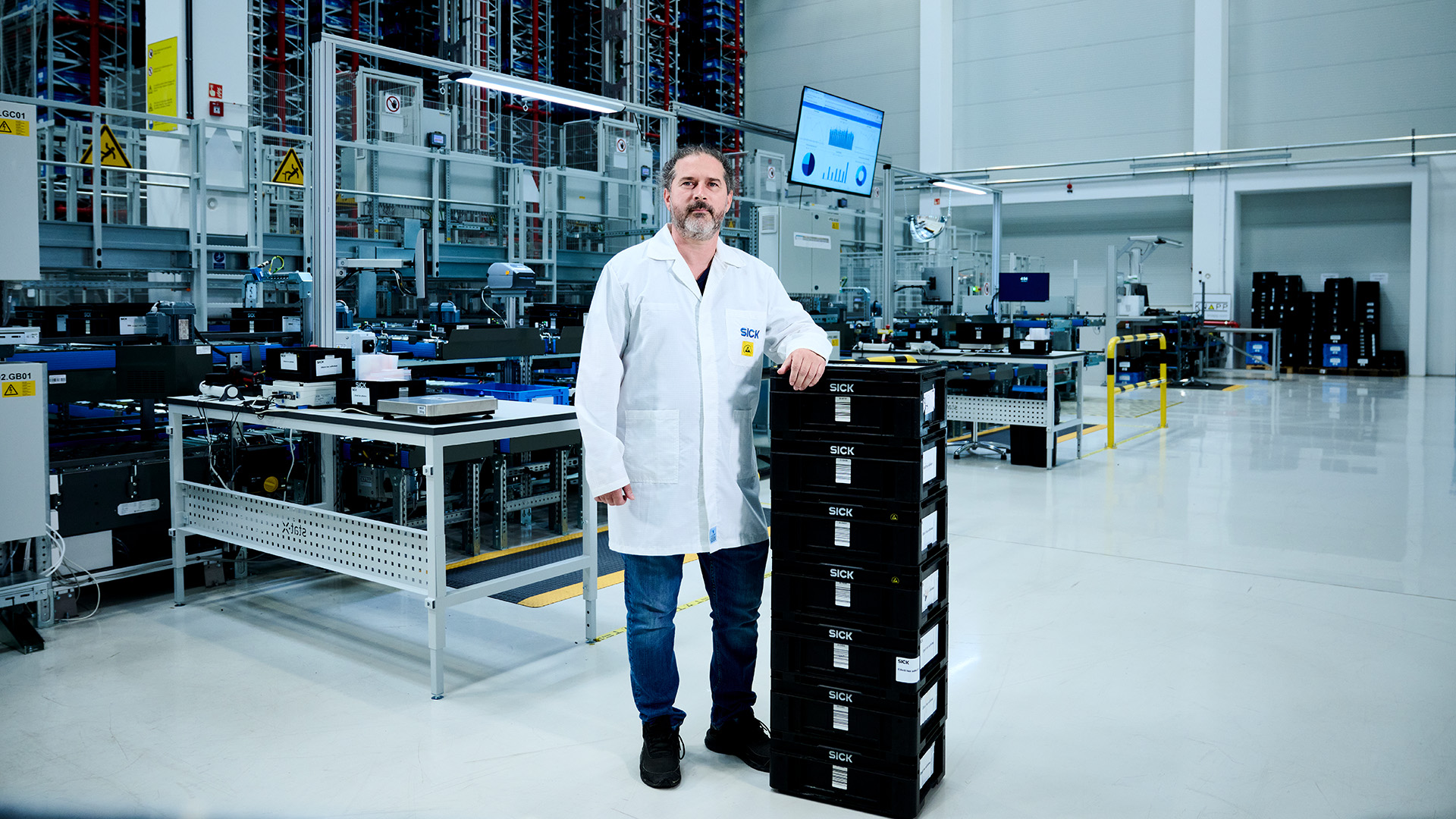
SICK and KNAPP both believe in innovation, quality and customer orientation, and are both technological leaders in their respective fields. The special partnership between SICK and KNAPP is characterized by trust and a focus on solutions and the future.
Laszlo Varga
Supply Chain Manager bei SICK Kft.

